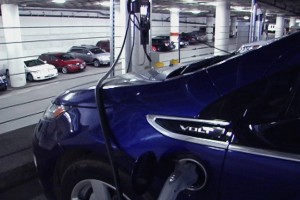 From a state beach in South County to a restaurant in East Providence to the parking lot of an office building in South Providence to the basement garage in the Department of Administration – they are gradually making a debut across Rhode Island.
From a state beach in South County to a restaurant in East Providence to the parking lot of an office building in South Providence to the basement garage in the Department of Administration – they are gradually making a debut across Rhode Island.
Electric vehicle charging stations. A total of 50 will be up and running by the end of September at a cost of three quarters of a million taxpayer dollars. It is one of the remaining pockets of federal stimulus money that Rhode Island received in 2009.
And the deadline to spend it is September 2013.
“We want to use that money in the state to do what it’s supposed to do, which is create jobs, reduce energy, move us toward a sustainable future,” said Marion Gold, commissioner of the Rhode Island Office of Energy Resources. Gold says the electric vehicle charging stations each cost about $15,000 and have two ports, so a total of 100 vehicles will be able to use them at any one time.
A global company called Charge Point won the $781,000 bid earlier this year and has already installed more than half of the 50. Private business owners are covering electricity costs at the charging stations on their property.
At the places where the stations are located on public property, like Fisherman’s State Park campground in Narragansett or Scarborough State Beach, electricity will be free to the motorist the first year. The stations eventually will be converted to take credit cards for the costs of charging. National Grid has agreed to maintain all of the ports.
The Chafee administration is leading by example. Gold is driving a Chevy Volt and Department of Transportation Director Mike Lewis and Administration Director Richard Licht are right next to her.
“We drive up, we park it, we plug it in; it charges up then we unplug it and we drive to where we’re going. In this case, we have a hybrid electric vehicle so it has a range of about 50 miles,” Gold said. “Once we go beyond 50 miles, then it goes to a backup gas engine.”
Gold’s office will conduct a pilot study over the next year on usage and costs, to develop a fee structure when motorists have to begin paying for the power themselves.
So how much do the vehicles cost? A new Volt runs about $35,000, with a $7,500 rebate from the federal government. A larger, high-powered Tesla with a longer battery life runs nearly $70,000 before rebate.
“And I’m having to convince my husband, who is more bottom-line oriented, because I really want to get an electric vehicle, and he keeps saying, ‘Marion, have you done the economics? Are you sure it’s the right investment?’” Gold said. “And I look at the research studies that say if you buy an electric vehicle versus a gas-powered you might save as much as $13,000 over the life of the vehicle.”
Exactly what period of time constitutes the life of the vehicle is unclear. And Gold acknowledges the savings directly correlate to where gas prices go in the future.
Hummel: Isn’t $5 gas going to work for you and $3 gas going to work against you?
Gold: There is no doubt that when gas prices go up, people start looking for alternatives like starting to take the train, starting to ride their bike and starting to look at electric vehicles.
And there are other variables. Gold said that a national database estimates an electric vehicle translates to about $1.60 a gallon in gas. Or 50 to 90 cents an hour to charge. But those are only estimates. Gold says it takes eight hours to fully charge her Volt.
Hummel: It’s a very complicated formula to tell somebody, “Okay, having this car is really the equivalent of having $1.60 gas or $2 gas.” Are you ever confident you’re going to be able to pinpoint that, or is that too many variables when you’re trying to sell to people?
Gold: I think the simple answer is, “Yeah, this is going to be cheaper for you and we’re going to have a lot of cars on the road to show that.”
Gold said she could not provide figures on how many electric vehicles are registered in Rhode Island because the registry doesn’t keep those stats, but the state is working to change that.
There clearly is going to be an adjustment period for the charging stations. We found no cars charging in eight locations we visited – probably because the stations are so new.
In the lot of one private business, where parking is tight, two non-electric cars were parked because there were no other spaces available. At East Matunuck State Beach, the two charging spots are located in a handicapped area near the pavilion. DEM says that will change when it can find another two handicapped spaces, but for now, those with handicapped tags take priority. It didn’t matter when we were there as both spaces were empty.
We also found two restaurants in East Providence – Cilantro and Chili’s – that have new stations, next to the takeout door at Chili’s and at the back of Cilantro’s parking lot.
“And the businesses are finding that, in fact, it’s a service to their customers so they’re not only willing to site it on their property, but have agreed to pay the electric fees for the first four years,” Gold said.
And she’s hoping the more electric cars people see on the roads and the more charging stations available, the more people will make the switch.
Gold: We’re hoping to work in partnership with the industry; we’re hoping to say that government is going to stand by this commitment to a zero emission vehicle future. We’re going to work in partnership with the American auto industry to make these cars available.
The Hummel Report is a 501 3C non-profit organization. If you have a story idea or want make a donation to the Hummel Report, go to www.hummelreport.org. Or mail Jim directly at jim@hummelreport.org

